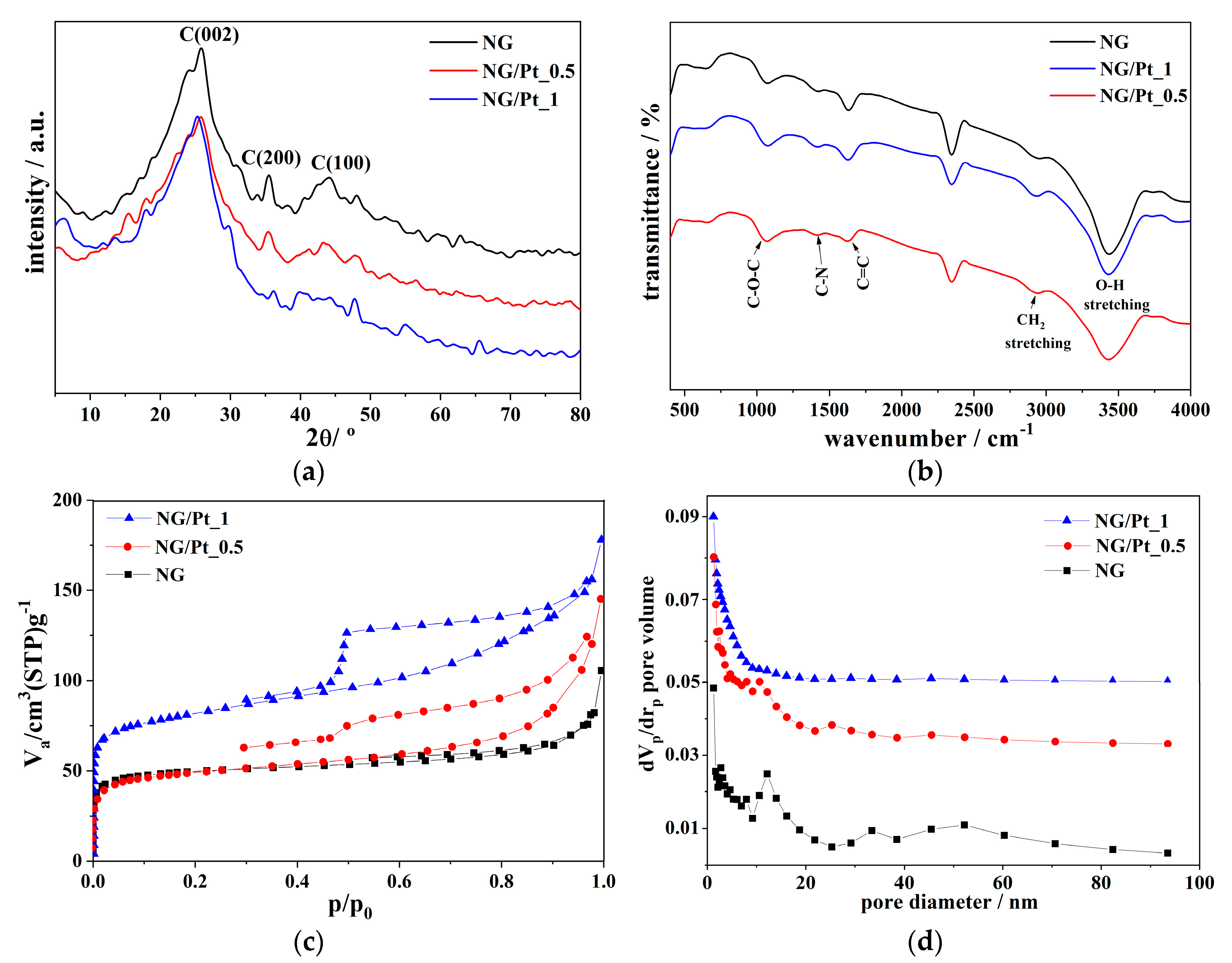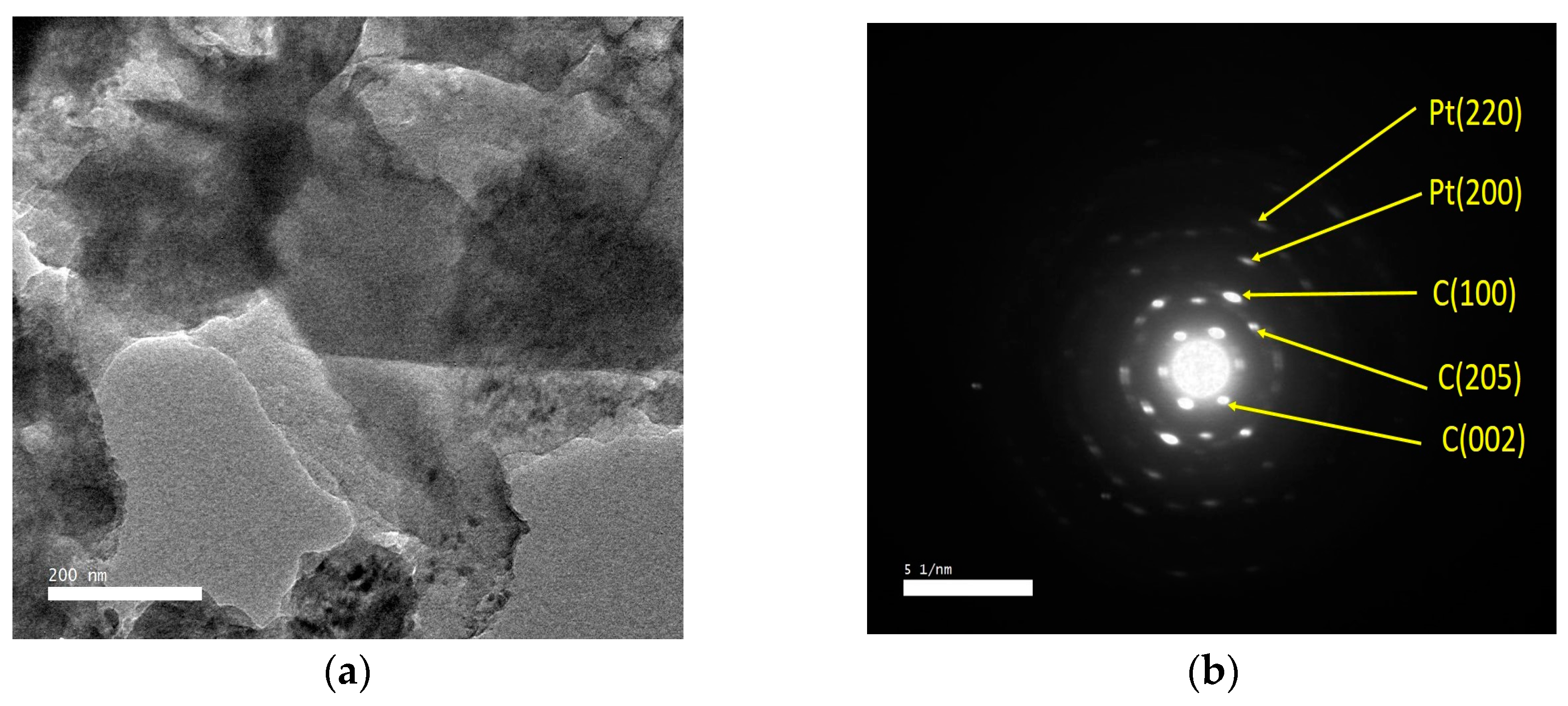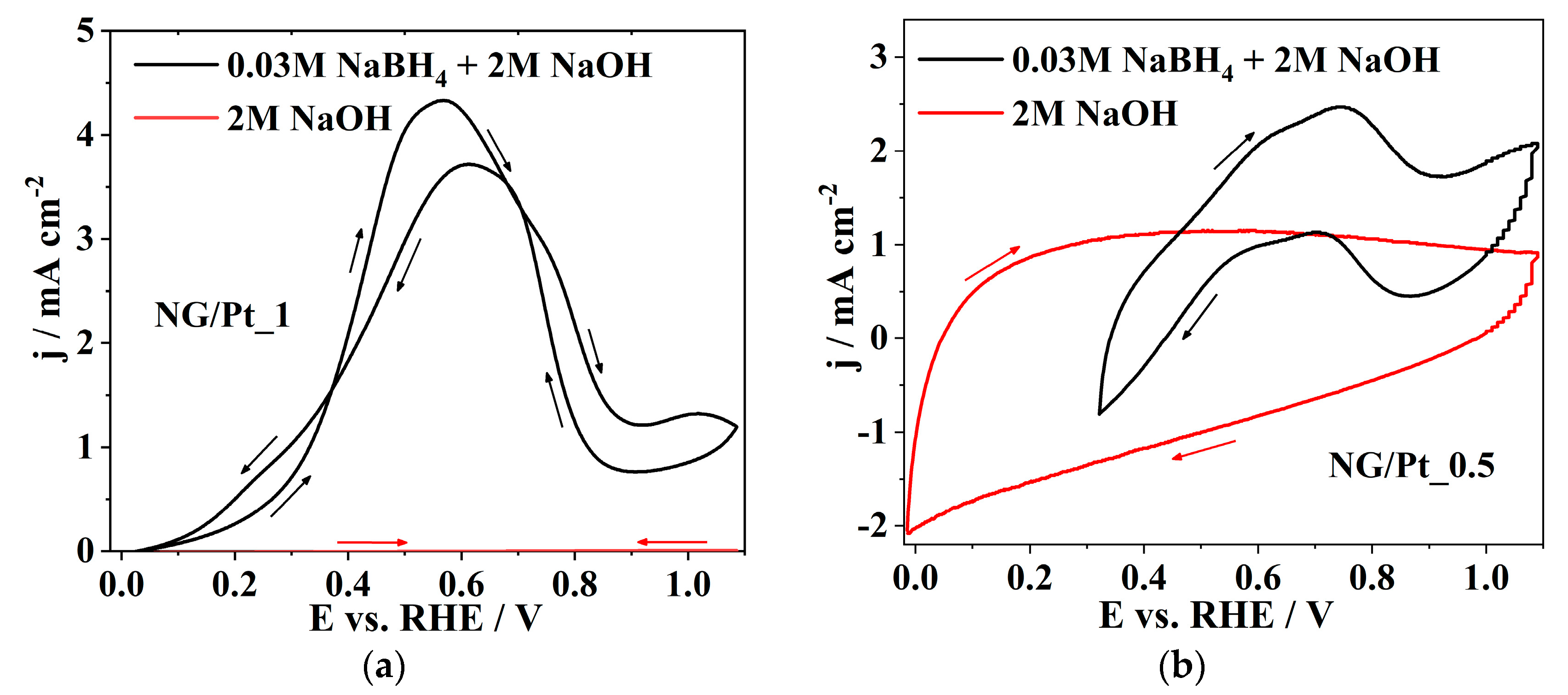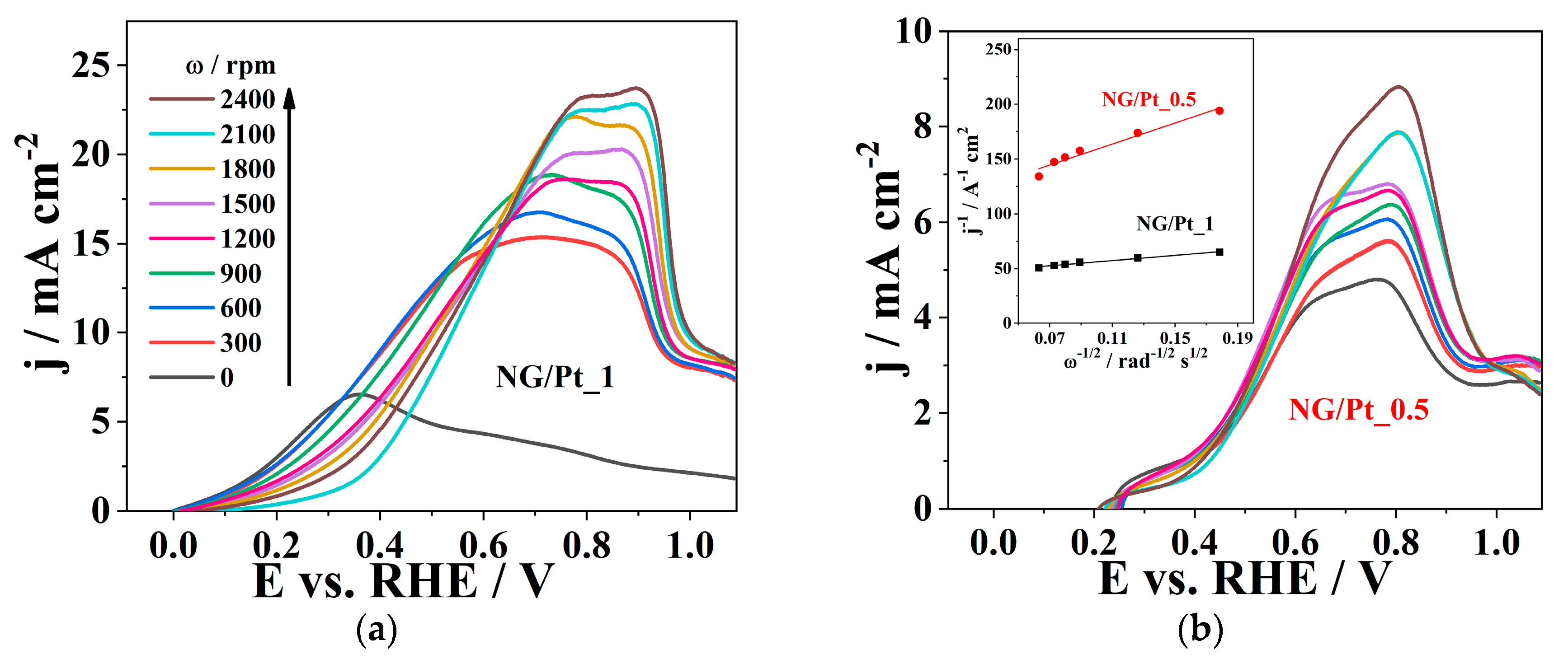From PET Bottles Waste to N-Doped Graphene as Sustainable Electrocatalyst Support for Direct Liquid Fuel Cells
Abstract
1. Introduction
2. Results and Discussion
2.1. Morphological and Structure Characterization of Graphene Doped-N and NG/Pt Catalysts
2.2. Electrochemical Measurements
3. Materials and Methods
3.1. Preparation
3.2. Characterization
3.3. Electrochemical Measurements
4. Conclusions
Author Contributions
Funding
Data Availability Statement
Acknowledgments
Conflicts of Interest
References
- Sloop, J.L. Liquid Hydrogen as a Propulsion Fuel; The NASA History Series; BASA-SP-4404, TL 785558, Stock Number 033-000–00707-8; NASA: Washington, DC, USA, 1978.
- Gouda, M.H.; Elessawy, N.A.; Toghan, A. Development of effectively costed and performant novel cation exchange ceramic nanocomposite membrane based sulfonated PVA for direct borohydride fuel cells. J. Ind. Eng. Chem. 2021, 100, 212–219. [Google Scholar] [CrossRef]
- Gouda, M.H.; Elessawy, N.A.; Al-Hussain, S.A.; Toghan, A. Design of promising green cation-exchange-membranes-based sulfonated pva and doped with nano sulfated zirconia for direct borohydride fuel cells. Polymers 2021, 13, 4205. [Google Scholar] [CrossRef]
- Gouda, M.H.; Elessawy, N.A.; Toghan, A. Novel crosslinked sulfonated PVA/PEO doped with phosphated titanium oxide nanotubes as effective green cation exchange membrane for direct borohydride fuel cells. Polymers 2021, 13, 2050. [Google Scholar] [CrossRef] [PubMed]
- Merino-Jimenez, I.; Ponce de Leo, C.; Shah, A.A.; Walsh, F.C. Developments in direct borohydride fuel cells and remaining challenges. J. Power Sources 2012, 219, 339–357. [Google Scholar]
- Merino-Jimenez, I.; Leon, C.P.D.; Walsh, F.C. The effect of surfactants on the kinetics of borohydride oxidation and hydrolysis in the DBFC. Electrochim. Acta 2014, 133, 539–545. [Google Scholar] [CrossRef]
- Olu, P.; Bonnefont, A.; Braesch, G.; Martin, V.; Savinova, E.; Chatenet, M. Influence of the concentration of borohydride towards hydrogen production and escape for borohydride oxidation reaction on Pt and Au electrodes e experimental and modelling insights. J. Power Sources 2018, 375, 300–309. [Google Scholar] [CrossRef]
- Oshchepkov, A.; Bonnefont, A.; Maranzana, G.; Savinova, E.; Chatenet, M. Direct borohydride fuel cells: A selected review of their reaction mechanisms, electrocatalysts, and influence of operating parameters on their performance. Curr. Opin. Electrochem. 2022, 32, 100883. [Google Scholar]
- Yi, L.; Yu, B.; Yi, W.; Zhou, Y.; Ding, R.; Wang, X. Carbon Supported Bimetallic Platinum-Iron Nanocatalysts: Application in Direct Borohydride/Hydrogen Peroxide Fuel Cell. ACS Sustain. Chem. Eng. 2018, 6, 8142–8149. [Google Scholar] [CrossRef]
- Rostamikia, G.; Janik, M.J. Direct borohydride oxidation: Mechanism determination and design of alloy catalysts guided by density functional theory. Energy Environ. Sci. 2010, 3, 1262–1274. [Google Scholar]
- Molina Concha, B.; Chatenet, M. Direct oxidation of sodium borohydride on Pt, Ag and alloyed Pt-Ag electrodes in basic media. Part I: Bulk electrodes. Electrochim. Acta 2009, 54, 6119–6129. [Google Scholar] [CrossRef]
- Cheng, K.; Jiang, J.; Kong, S.; Gao, Y.; Ye, K.; Wang, G.; Zhang, W.; Cao, D. Pd nanoparticles support on rGO-C@TiC coaxial nanowires as a novel 3D electrode for NaBH4 electrooxidation. Int. J. Hydrogen Energy 2017, 42, 2943–2951. [Google Scholar] [CrossRef]
- Oshchepkov, A.; Braesch, G.; Ould-Amara, S.; Rostamikia, G.; Maranzana, G.; Bonnefont, A.; Papaefthimiou, V.; Janik, M.; Chatenet, M.; Savinova, E. Nickel Metal Nanoparticles as Anode Electrocatalysts for Highly Efficient Direct Borohydride Fuel Cells. ACS Catal. 2019, 9, 8520–8528. [Google Scholar]
- Hjelm, R.M.E.; Lafforgue, C.; Atkinson, R.W., III; Garsany, Y.; Stroman, R.O.; Chatenet, M.; Swider-Lyons, K. Impact of the Anode Catalyst Layer Design on the Performance of H2O2-Direct Borohydride Fuel Cells. J. Electrochem. Soc. 2019, 166, F1218. [Google Scholar] [CrossRef]
- Oshchepkov, A.G.; Braesch, G.; Rostamikia, G.; Bonnefont, A.; Janik, M.J.; Chatenet, M.; Savinova, E.R. Insights into the borohydride electrooxidation reaction on metallic nickel from operando FTIRS, on-line DEMS and DFT. Electrochim. Acta 2021, 389, 138721. [Google Scholar] [CrossRef]
- Vorms, E.A.; Suprun, E.A.; Nartova, A.V.; Kvon, R.I.; Oshchepkov, A.G. Electrodeposited NiCu nanoparticles for the borohydride oxidation reaction: Effect of Cu on the activity and stability of Ni upon surface oxidation. Electrochim. Acta 2022, 433, 141196. [Google Scholar]
- Saha, S.; Gayen, P.; Wang, Z.; Dixit, R.J.; Sharma, K.; Basu, S.; Ramani, V.K. Development of Bimetallic PdNi Electrocatalysts toward Mitigation of Catalyst Poisoning in Direct Borohydride Fuel Cells. ACS Catal. 2021, 11, 8417–8430. [Google Scholar] [CrossRef]
- Santos, D.M.F.; Eugénio, S.; Cardoso, D.S.P.; Šljukić, B.; Montemor, M.F. Three-dimensional nanostructured Ni-Cu foams for borohydride oxidation. Russ. J. Phys. Chem. A 2015, 89, 2449–2454. [Google Scholar] [CrossRef]
- Jovanović, T.; Milikić, J.; Cvjetićanin, N.; Stojadinović, S.; Šljukić, B. Performance of Au/Ti and Au/TiO2 nanotube array electrodes for borohydride oxidation and oxygen reduction reaction in alkaline media. Electroanalysis 2020, 32, 1867–1874. [Google Scholar] [CrossRef]
- Milikić, J.; Martins, M.; Dobrota, A.S.; Bozkurt, G.; Soylu, G.S.P.; Yurtcan, A.B.; Skorodumova, N.V.; Pašti, I.A.; Šljukić, B.; Santos, D.M.F. A Pt/MnV2O6 nanocomposite for the borohydride oxidation reaction. J. Energy Chem. 2021, 55, 428–436. [Google Scholar] [CrossRef]
- McCrum, I.T.; Janik, M.J. First Principles Simulations of Cyclic Voltammograms on Stepped Pt(553) and Pt(533) Electrode Surfaces. ChemElectroChem 2016, 3, 1609–1617. [Google Scholar] [CrossRef]
- Song, C.; Sun, X.; Ye, K.; Zhu, K.; Cheng, K.; Yan, J.; Cao, D.; Wang, G. Electrocatalytic activity of MnO2 supported on reduced graphene oxide modified Ni foam for H2O2 reduction. Acta Chim. Sin. 2017, 75, 1003–1009. [Google Scholar] [CrossRef]
- Cai, Z.; Wang, G.; Song, C.; Yang, X.; Hu, R.; Ye, K.; Zhu, K.; Cheng, K.; Yan, J.; Cao, D. Preparation of a binder free electrode of NiAg supported on graphite modified A4 paper and its electrochemical performance for H2O2 reduction. Chem. J. Chin. Univ. 2018, 39, 1041–1047. [Google Scholar]
- Zhao, J.; Gong, J.; Li, Y.; Cheng, K.; Ye, K.; Zhu, K.; Yan, J.; Cao, D.; Wang, G. Self N-doped porous interconnected carbon nanosheets material for supercapacitors. Acta Chim. Sin. 2018, 76, 107–112. [Google Scholar] [CrossRef]
- He, D.; Tang, H.; Kou, Z.; Pan, M.; Sun, X.; Zhang, J.; Mu, S. Engineered graphene materials: Synthesis and applications for polymer electrolyte membrane fuel cells. Adv. Mater. 2017, 29, 1601741. [Google Scholar] [CrossRef] [PubMed]
- Kou, Z.; Meng, T.; Guo, B.; Amiinu, I.S.; Li, W.; Zhang, J.; Mu, S. A generic conversion strategy: From 2D metal carbides (MxCy) to M-self-doped graphene toward highefficiency energy applications. Adv. Funct. Mater. 2017, 27, 1604904. [Google Scholar] [CrossRef]
- Fang, Y.; Hu, R.; Liu, B.; Zhang, Y.; Zhu, K.; Yan, J.; Ye, K.; Cheng, K.; Wang, G.; Cao, D. MXene-derived TiO2/reduced graphene oxide composite with an enhanced capacitive capacity for Li-ion and K-ion batteries. J. Mater. Chem. A 2019, 7, 5363–5372. [Google Scholar] [CrossRef]
- Taqi-uddeen Safian, M.; Umar, K.; Mohamad Ibrahim, M.N. Synthesis and scalability of graphene and its derivatives: A journey towards sustainable and commercial material. J. Clean. Prod. 2021, 318, 128603. [Google Scholar] [CrossRef]
- Yaqoob, A.A.; Mohamad Ibrahim, M.N.; Umar, K.; Bhawani, S.A.; Khan, A.; Asiri, A.M.; Rizwan Khan, M.; Azam, M.; Al Ammari, A.M. Cellulose Derived Graphene/Polyaniline Nanocomposite Anode for Energy Generation and Bioremediation of Toxic Metals via Benthic Microbial Fuel Cells. Polymers 2021, 13, 135. [Google Scholar] [CrossRef]
- Wu, G.; Santandreu, A.; Kellogg, W.; Gupta, S.; Ogoke, O.; Zhang, H.; Wang, H.-L.; Dai, L. Carbon nanocomposite catalysts for oxygen reduction and evolution reactions: From nitrogen doping to transition-metal addition. Nano Energ. 2016, 29, 83–110. [Google Scholar] [CrossRef]
- Li, B.; Song, C.; Huang, X.; Ye, K.; Cheng, K.; Zu, K.; Yan, J.; Cao, D.; Wang, G. A novel anode for direct borohydride-hydrogen peroxide fuel cell: Au nanoparticles decorated 3D self-supported reduced graphene oxide foam. ACS Sustain. Chem. Eng. 2019, 7, 11129–11137. [Google Scholar] [CrossRef]
- Chen, Z.; Wei, W.; Ni, B.-J.; Chen, H. Plastic wastes derived carbon materials for green energy and sustainable environmental application. Environ. Funct. Mater. 2022, 1, 34–48. [Google Scholar] [CrossRef]
- Yaqoo, L.; Noor, T.; Iqbal, N. Conversion of Plastic Waste to Carbon-Based Compounds and Application in Energy Storage Devices. ACS Omega 2022, 7, 13403–13435. [Google Scholar] [CrossRef] [PubMed]
- Elessawy, N.A.; El Nady, J.; Wazeer, W. Development of High-Performance Supercapacitor based on a Novel Controllable Green Synthesis for 3D Nitrogen Doped Graphene. Sci. Rep. 2019, 9, 1129. [Google Scholar] [CrossRef]
- Yao, R.; Gu, J.; He, H.; Yu, T. Improved Electrocatalytic Activity and Durability of Pt Nanoparticles Supported on Boron-Doped Carbon Black. Catalysts 2020, 10, 862. [Google Scholar] [CrossRef]
- Elkady, M.; Hamad, H.A.; Essawy, N.E. Modification of optical and electrical properties of nanocrystalline VO2.0.5H2O/ZrV2O7: Influence of Cs, Cr and Ga doping. J. Mater. Res. Technol. 2019, 8, 1212–1223. [Google Scholar] [CrossRef]
- Mohamed, M.; Elessawy, N.; Carrasco-Marínc, F.; Hamad, H.A.F. A novel one-pot facile economic approach for the mass synthesis of exfoliated multilayered nitrogen-doped graphene-like nanosheets: New insights into the mechanistic study. Phys. Chem. Chem. Phys 2019, 21, 13611. [Google Scholar] [CrossRef] [PubMed]
- Mohamed, M.; Carrasco-Marín, F.; Elessawy, N.A.; Hamad, H.A.F. GlucoseDerived NDoped Graphitic Carbon: Facile OnePot Graphitic StructureControlled Chemical Synthesis with Comprehensive Insight into the Controlling Mechanisms. ChemistrySelect 2020, 5, 14685–14702. [Google Scholar] [CrossRef]
- Gouda, M.H.; Elnouby, M.; Aziz, A.; Youssef, M.; Santos, D.M.F.; Elessawy, N.A. Green and low-cost membrane electrode assembly for proton exchange membrane fuel cells: Effect of double-layer electrodes and gas diffusion layer. Front. Mater. 2020, 6, 337. [Google Scholar] [CrossRef]
- Al-Gaashani, R.; Najjar, A.; Zakaria, Y.; Mansour, S.; Atieh, M.A. XPS and structural studies of high-quality graphene oxide and reduced graphene oxide prepared by different chemical oxidation methods. Ceram. Int. 2019, 45, 14439–14448. [Google Scholar] [CrossRef]
- Ariharan, A.; Viswanathan, B.; Nandhakumar, V. Nitrogen Doped Graphene as Potential Material for Hydrogen Storage. Graphene 2017, 6, 41–60. [Google Scholar] [CrossRef]
- Arteaga, G.; Rivera-Gavidia, L.M.; Martínez, S.J.; Rizo, R.; Pastor, E.; García, G. Methanol Oxidation on Graphenic-Supported Platinum Catalysts. Surfaces 2019, 2, 16–31. [Google Scholar] [CrossRef]
- Xin, Y.; Liu, J.-G.; Zhou, Y.; Liu, W.; Gao, J.; Xie, Y.; Yin, Y.; Zou, Z. Preparation and characterization of Pt supported on graphene with enhanced electrocatalytic activity in fuel cell. J. Power Sources 2011, 3, 1012–1018. [Google Scholar] [CrossRef]
- Rakočević, L.; Simatović, I.S.; Maksić, A.; Rajić, V.; Štrbac, S.; Srejić, I. PtAu Nanoparticles Supported by Reduced Graphene Oxide as a Highly Active Catalyst for Hydrogen Evolution. Catalysts 2022, 12, 43. [Google Scholar] [CrossRef]
- Šljukić, B.; Santos, D.M.F. Chapter 10—Direct Borohydride Fuel Cells (DBFCs). In Direct Liquid Fuel Cells; Akay, R.G., Yurtcan, A.B., Eds.; Academic Press: New York, NY, USA, 2021; pp. 203–232. [Google Scholar] [CrossRef]
- Hjelm, S.R.M.E.; Garsany, Y.; Atkinson, R.W., III; Stroman, R.O.; Swider-Lyons, K.; Lafforgue, C.; Chatenet, M. Sodium Borohydride Oxidation on Pt and/or Pd-Based Electrodes in Hydrogen Peroxide Direct Borohydride Fuel Cells (H2O2-DBFCs). ECS Trans. 2017, 80, 1033–1042. [Google Scholar] [CrossRef]
- Šljukić, B.; Milikić, J.; Santos, D.M.F.; Sequeira, C.A.C.; Macciò, D.; Saccone, A. Electrocatalytic performance of Pt-Dy alloys for direct borohydride fuel cells. J. Power Sources 2014, 272, 335–343. [Google Scholar] [CrossRef]
- Braesch, G.; Bonnefont, A.; Martin, V.; Savinova, E.R.; Chatenet, M. Borohydride oxidation reaction mechanisms and poisoning effects on Au, Pt and Pd bulk electrodes: From model (low) to direct borohydride fuel cell operating (high) concentrations. Electrochimi. Acta 2018, 273, 483–494. [Google Scholar] [CrossRef]
- Oliveira, R.C.P.; Milikić, J.; Daş, E.; Yurtcan, A.B.; Santos, D.M.F.; Šljukić, B. Platinum/polypyrrole-carbon electrocatalysts for direct borohydride-peroxide fuel cells. App. Catal. B 2018, 238, 454–464. [Google Scholar] [CrossRef]
- Liu, J.; Wang, H.; Wu, C.; Zhao, Q.; Wang, X.; Yi, L. Preparation and characterization of nanoporous carbon-supported platinum as anode electrocatalyst for direct borohydride fuel cell. Int. J. Hydrogen Energy. 2014, 39, 6729–6736. [Google Scholar] [CrossRef]
- Abdolmaleki, M.; Hosseini, M.G. A development in direct borohydride/hydrogen peroxide fuel cell using nanostructured Ni-Pt/C anode. Fuel Cells 2017, 17, 321–327. [Google Scholar] [CrossRef]
- Sombatmankhong, K. Improved performance and stability of direct borohydride fuel cells (DBFCs) with porous polypyrrole. J. Porous Mater. 2015, 22, 675–687. [Google Scholar] [CrossRef]
- Mohan, V.B.; Jayaraman, K.; Bhattacharyya, D. Brunauer–Emmett–Teller (BET) specific surface area analysis of different graphene materials: A comparison to their structural regularity and electrical properties. Solid State Commun. 2020, 320, 114004. [Google Scholar] [CrossRef]
- Kadioglu, T.; Turkmen, A.C.; Ata, K.C.; Akay, R.G.; Tikiz, I.; Celik, C. Investigation of the performance of a direct borohydride fuel cell with low Pt/C catalyst loading under different operating conditions. Int. J. Hydrogen Energy 2020, 45, 35006–35012. [Google Scholar] [CrossRef]








| Surface Area (BET) (m2 g−1) | Mean Pore Diameter (nm) | |
|---|---|---|
| NG | 187 | 3.17 |
| NG/Pt_0.5 NG/Pt_1 | 181 303 | 3.54 4.75 |
| Anode | Separator | Fuel | Oxidant | T/°C | Pmax/W mgPt−1 | jmax/mAcm−2 | Source |
|---|---|---|---|---|---|---|---|
| Pt/PPy2-C12% (0.04 mgPt cm−2) | Nafion 117 | 1 M NaBH4 + 4 M NaOH | 5 M H2O2 + 1.5 M HCl | RT1 | 0.57 | 70.3 | [8] |
| Pt/PPy2-C20% (0.04 mgPt cm−2) | Nafion 117 | 1M NaBH4 + 4 M NaOH | 5 M H2O2 + 1.5 M HCl | RT1 | 0.75 | 76.0 | [8] |
| Pt/PPy2-C35% (0.06 mgPt cm−2) | Nafion 117 | 1 M NaBH4 + 4 M NaOH | 5 M H2O2 + 1.5 M HCl | RT1 | 0.79 | 120 | [8] |
| Pt/NPC3 (4 mgPt cm−2) | Nafion 117 | 1 M NaBH4 + 3 M NaOH | 2 M H2O2 + 0.5 M H2SO4 | RT1 | 0.01 | 120 | [10] |
| Pt/CB4 (0.5 mgPt cm−2) | Nafion 117 | 0.1 M NaBH4 + 6 M NaOH | 0.1 M H2O2 | RT1 | 0.01 | 18.0 | [47] |
| PtNi/C (1 mgPtNi cm−2) | Nafion 117 | 1 M NaBH4 + 2 M NaOH | 2 M H2O2 + 0.5 M H2SO4 | 45 | 0.57 | 100 | [46] |
| NG/Pt_1 (0.02 mgPt cm−2) | Nafion 117 | 1 M NaBH4 + 4 M NaOH | 5 M H2O2 + 1.5 M HCl | 45 | 15.8 | 137 | This study |
Disclaimer/Publisher’s Note: The statements, opinions and data contained in all publications are solely those of the individual author(s) and contributor(s) and not of MDPI and/or the editor(s). MDPI and/or the editor(s) disclaim responsibility for any injury to people or property resulting from any ideas, methods, instructions or products referred to in the content. |
© 2023 by the authors. Licensee MDPI, Basel, Switzerland. This article is an open access article distributed under the terms and conditions of the Creative Commons Attribution (CC BY) license (https://creativecommons.org/licenses/by/4.0/).
Share and Cite
Elessawy, N.A.; Backović, G.; Hirunthanawat, J.; Martins, M.; Rakočević, L.; Gouda, M.H.; Toghan, A.; Youssef, M.E.; Šljukić, B.; Santos, D.M.F. From PET Bottles Waste to N-Doped Graphene as Sustainable Electrocatalyst Support for Direct Liquid Fuel Cells. Catalysts 2023, 13, 525. https://doi.org/10.3390/catal13030525
Elessawy NA, Backović G, Hirunthanawat J, Martins M, Rakočević L, Gouda MH, Toghan A, Youssef ME, Šljukić B, Santos DMF. From PET Bottles Waste to N-Doped Graphene as Sustainable Electrocatalyst Support for Direct Liquid Fuel Cells. Catalysts. 2023; 13(3):525. https://doi.org/10.3390/catal13030525
Chicago/Turabian StyleElessawy, Noha A., Gordana Backović, Janesuda Hirunthanawat, Marta Martins, Lazar Rakočević, Marwa H. Gouda, Arafat Toghan, Mohamed E. Youssef, Biljana Šljukić, and Diogo M. F. Santos. 2023. "From PET Bottles Waste to N-Doped Graphene as Sustainable Electrocatalyst Support for Direct Liquid Fuel Cells" Catalysts 13, no. 3: 525. https://doi.org/10.3390/catal13030525
APA StyleElessawy, N. A., Backović, G., Hirunthanawat, J., Martins, M., Rakočević, L., Gouda, M. H., Toghan, A., Youssef, M. E., Šljukić, B., & Santos, D. M. F. (2023). From PET Bottles Waste to N-Doped Graphene as Sustainable Electrocatalyst Support for Direct Liquid Fuel Cells. Catalysts, 13(3), 525. https://doi.org/10.3390/catal13030525









